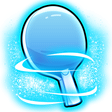Rubber Pores Throw Angle
Equipment
William Do Asked 10 years ago
Hi Alois and Jeff,
I was looking at some rubber reviews and i stumbled upon the terms throw angle and pores. Could you explain what these are on rubbers.
Thanks
 Alois Rosario Answered 10 years ago
Alois Rosario Answered 10 years ago
Hi William,
The Throw Angle is the amount of grip on the surface so that when you make a topspin for example, the ball will be easier to lift especially against a backspin ball.
The pores I think is the air in the sponge. Some sponge is very dense and others less dense so that you can see bubbles within the sponge. Someone please correct me if I am have got it wrong.
Recommended Video
Thoughts on this question
Become a free member to post a comment about this question.
Jean Balthazar Posted 10 years ago
Hi there,
Regarding the throw angle, as weird as it seems, the blade has its own one too. I really can't explain it, but I experienced it first hand. Xiom vega Pro is a rubber known to have a high throw angle. Last season I played it on a Butterfly Maze T-Tec All+ blade. This season I switched to a Dr. Neubauer Bulldog blade. With the same rubber, the throw angle is much lower. I didn't like it at all first, many of my topspins landed in the net. But the incredible control of the bat made me persist, and now I really benefit from a much better capability to keep the ball low in the short game. So sorry, no technical explanation from my side. Read the reviews. They're not always very accurate, but if you find a lot saying the same thing about the throw angle of a certain rubber or blade, there's probably some truth to it. Here you can see an interesting comparison of throw angle for the same rubber in different sponge thickness (and then more rubbers) : https://www.youtube.com/watch?v=1pY_iHtycaA.
Regarding the pores, I think you got it right Alois. The rubber with the widest pores I used so far was the Joola Maxx 400 (and it was awful to cut). The Xiom Vega Pro has smaller ones. The Yasaka Mark V pores are almost not visible. I noticed that the larger the pores, the more the rubber has a tendency to shrink after gluing (not sure if it expands with the glue and then comes back to its original size when dry, or if it becomes smaller than original). Now regarding the performance of a rubber, does larger pores mean better? I don't know. But it looks like modern rubbers tend to have larger pores.
Ciao.